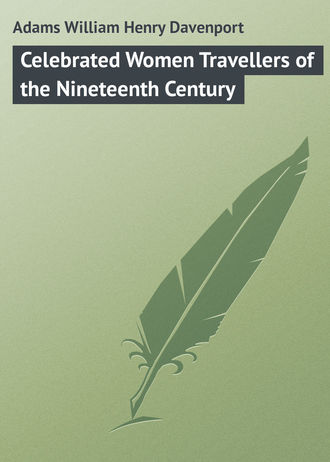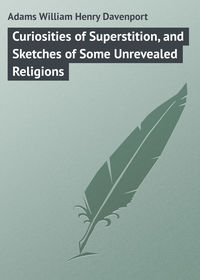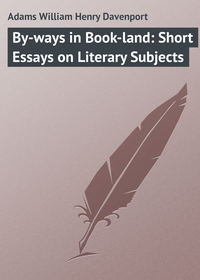 полная версия
полная версияCelebrated Women Travellers of the Nineteenth Century
On a sunny afternoon half the population of the latter town may be seen "disporting themselves in, upon, and beneath the water." Climbing the steep and rugged rocks that form the opposite bank, they take headers and footers and siders from any elevation under five-and-twenty feet, diving and swimming in every imaginable attitude, and with a kind of easy and spontaneous grace that commands admiration. One of their great feats is thus described: A couple of natives undertake to jump from a precipice, one hundred feet high, into the river below, clearing in their descent a rock, which at about a distance of twenty feet from the summit, projects as far from the face of the cliff. The two men – lithe, tall, and strong – are seen standing on the green height, their long hair confined by a wreath of leaves and flowers, while a similar wreath is twisted round the waist. With a keen, quick glance they measure the distance, and fall back some yards, in order to run and acquire the needful impetus. Suddenly one of them reappears, takes a flying leap from the rock, executes a somersault in mid-air, and feet foremost plunges into the pool beneath, to rise again almost immediately, and climb the steep river-bank with an air of serene indifference. His companion having performed the same exploit, the two clambered up to the projection of which we have spoken, and again dropped into the river waters; a less wonderful feat than their former, but still one requiring both pluck and skill.
Among the games mentioned by Lady Brassey are spear-throwing, transfixing an object with a dart, kona, an elaborate kind of draughts, and talu, which consists in hiding a small stone under one of five pieces of cloth placed in front of the players. One hides the stone, and his companions have to guess where it is hidden; and it generally happens that, however skilfully the hider may glide his arm under the cloth and shift from one piece to another, a clever player detects where he lets go the stone by the movement of the muscles of the upper part of his arm. Another game, tarua, resembles the Canadian sport of "tobogonning," only it is carried on upon the grass instead of upon the frozen surface of the snow. The performers stand erect on a narrow plank, turned up in front, which they guide with a kind of paddle. Starting from the summit of a hill or a mountain, they sweep down the grassy slopes at a furious pace, preserving their balance with admirable dexterity. For the game of pahé, which is also very popular, a specially prepared smooth floor is necessary, and along this the javelins of the players glide like snakes. On the same kind of floor they play maita, or uru maita. Two sticks are fixed in the ground, only a few inches apart, and from a distance of thirty or forty yards the player seeks to throw a stone – the uru– between them; the uru being circular in shape, three or four inches in diameter, and an inch in thickness, except at the middle, where it is thicker.34
We pass on to Japan, and accompany Lady Brassey to a Japanese dinner in a Japanese tea-house. The dinner took place in an apartment which, as an exact type of a room in any Japanese house, may fitly be described. The roof and the screens, which form the sides, are all made of a handsome dark-polished wood resembling walnut. The exterior walls under the verandah, as well as the partitions between the other rooms, are simply screens of wooden lattice-work, covered with white paper, and sliding in grooves; so that a person walks in or out at any part of the wall he thinks proper to select or finds convenient. This arrangement necessarily dispenses with doors and windows. If you wish to look out, you open a little bit of your wall, or a larger bit if you step out. Instead of carpets, the floor is strewn with several thicknesses of very fine mats, each about six feet long by three feet broad, "deliciously soft to walk upon." All Japanese mats are of the same size, and they constitute the standard by which everything connected with house-building or house-furnishing is measured. Once you have prepared your foundations and woodwork of the dimensions of so many mats, you may go to a shop and buy a ready-made house, which you can then set up and furnish in the light Japanese fashion in a couple of days; but then such a house is fitted only for a Japanese climate.
In the room into which Lady Brassey was introduced was raised, on one side, a slight daïs, about four inches from the floor, as a seat of honour. A stool, a little bronze ornament, and a China vase, in which a branch of cherry-blossom and a few flag-leaves were gracefully arranged, occupied it. On the wall behind hung pictures, which are changed every month, according to the season of the year. Four comely Japanese girls brought thick cotton quilts for the visitors to sit upon, and braziers full of burning charcoal that they might warm themselves. In the centre they placed another brazier, protected by a square wooden grating, with a large silk eider-down quilt laid over it, to keep in the heat. "This is the way in which all the rooms, even bedrooms, are warmed in Japan, and the result is that fires are of very frequent occurrence. The brazier is kicked over by some restless or careless person, and in a moment the whole place is in a blaze."
In due time brazier and quilt are removed, and dinner makes its appearance. Before each guest is placed a small lacquer table, about six inches high, with a pair of chopsticks, a basin of soup, a bowl of rice, a saki cup, and a basin of hot water; while in the middle sat the four Japanese Hebes, with fires to keep the saki hot, and light the long pipes they carried, from which they wished their visitors to take a whiff after each dish. Saki is a kind of spirit, distilled from rice, always drunk hot out of small cups. It is not unpleasant in this state, but when cold few European palates can relish it.
The Japanese cookery was very good, though some of the dishes were compounded of ingredients not generally mixed together by the cooks of the West. Here is the bill of fare: —
Soup.
Shrimps and Seaweeds.
Prawns, Egg Omelette, and Preserved Grapes.
Fried Fish, Spinach, Young Rushes, and Young Ginger.
Raw Fish, Mustard and Cress, Horseradish, and Soy.
Thick Soup – of Eggs, Fish, Mushrooms, and Spinach; Grilled
Fish.
Fried Chicken and Bamboo Shoots.
Turnip Tops and Root Pickled.
Rice ad libitum in a large bowl.
Hot Saki, Pipes, and Tea.
The last dish presented was an enormous lacquer box of rice, from which all the bowls were filled – the rice being thence carried to the mouth of each guest by means of chopsticks, in the use of which it is only practice that makes perfect.
Between each course a long interval occurred, which was filled up with songs, music, and dancing, performed by professional singing and dancing girls. The music was somewhat harsh and monotonous; but a word of praise may be given to the songs and to the dancing, or rather posturing, for there was little of that agility of foot practised by European dancers. "The girls, who were pretty, wore peculiar dresses to indicate their calling, and seemed of an entirely different stamp from the quiet, simply-dressed waitresses whom we found so attentive to our wants; still they all looked cheery, light-hearted, simple creatures, and appeared to enjoy immensely the little childish games they played amongst themselves between whiles."35
This "Voyage Round the World," from which we must now turn aside, does not sum up Lady Brassey's achievements as a traveller. She accompanied her husband, in 1874, on a cruise to the Arctic Circle, but has published no record of this enterprise. On their return, the indefatigable couple started on a voyage to the East, visiting Constantinople, the city of gilded palaces and mosques, of harems and romance; and skimming the sunny waters of the Bosphorus and the Golden Horn. In 1878 they made a second excursion to the Mediterranean, revisiting Constantinople, and seeing it in storm and shadow as they had previously seen it in sunshine; and exploring Cyprus, which then had been but recently brought under British dominion. Lady Brassey's narrative of her Mediterranean cruises and Oriental experiences has the distinctive merits of her former work – the same unpretending simplicity and clearness of style, the same quick appreciation of things that float upon the surface; but it necessarily lacks its interest and special value. It goes over familiar – nay, over hackneyed – ground, and thus inevitably comes into comparison with the works of preceding travellers, such as Miss Martineau and the author of "Eöthen," to whose high standard Lady Brassey would be the first to acknowledge that she has no pretensions to attain.
There is a certain amount of freshness in the following brief sketch of Athens36: —
"We drove first to the Temple of Theseus, the most perfectly preserved temple of the ancient world. The situation has sheltered it from shot and shell; but, without doubt, it owes its escape from destruction in part to the circumstance that in the Middle Ages it was consecrated as a church. It is a beautiful building, with its double row of columns, bas-reliefs, and roof all perfect, and now contains an interesting collection of antiquities, gathered from its immediate neighbourhood. Thence we drove up the hill to the Acropolis, passing on our way the modern observatory on the Hill of the Nymphs. The Hill of Pnyx rose on our right, and the Areopagus, where St. Paul preached, on our left. We entered the gates, and, passing among ruins of all kinds – statues, bas-reliefs, columns, capitals, and friezes – soon approached the propylæa. Then we went to the little Temple of Victory, closed with iron gates, and full of most exquisite bits of statues and bas-reliefs, specially two dancing girls, graceful in attitude and full of life and action. After these preliminary peeps at loveliness and art, we went up the long flight of steps, past the Pinartheca, and soon stood on the top of the Hill of the Acropolis, and in full view of all its glories.
"On one side was the splendid Parthenon, on the other the Erechtheum, with the Porch of Caryatides, called Beautiful, and right well it deserves its name. Six noble columns are still standing. We strolled about for a long time, took some photographs, admired the lovely panoramic view from the top – over the town of Athens to Eleusis, Salamis, and Corinth on one side, and from Mount Pentelicus and Mount Hymettus to the Elysian Fields, till our eyes wandered round by the ancient harbours of Phalisum and Piræus; back again by the Street of Tombs to Athens, looking more dusty and more grey than ever as we gazed down on its grey-tiled roofs. Even the gardens and palm-trees hardly relieved it. It was nearly three o'clock before we could tear ourselves away."
This is very natural and simple, though it is hardly what we should expect from a cultivated woman after visiting the memorials of Greek art and history, and the great and beautiful city of the "violet moon." A greater enthusiasm, a more living sympathy, might surely have been provoked by the sight of the blue sea where Themistocles repulsed the navies of Persia, and the glorious hill on whose crest St. Paul spake to the wondering Athenians, and the monuments of the genius of Praxiteles and Phidias. Lady Brassey, however, is not at her best when treating of the places and things which antiquity has hallowed: it is the aspects of the life of to-day and the picturesque scenes of savage lands that arrest her attention most firmly, and are reproduced by her most vividly. She is more at home in the Hawaiian market than among the ruined temples of Athens.
The reader may not be displeased to take a glance at Nikosia, the chief town of Cyprus – of that famous island which calls up such stirring memories of the old chivalrous days when Richard I. and his Crusaders landed here, and the lion-hearted king became enamoured of Berengaria, the daughter of the Cypriot prince.
"The town is disappointing inside," she says, "although there are some fine buildings still left. The old cathedral of St. Sophia, now used as a mosque, is superb in the richness of its design and tracery, and the purity of its Gothic architecture. Opposite the cathedral is the Church of St. Nicholas, now used as a granary. The three Gothic portals are among the finest I have ever seen. Every house in Nikosia possesses a luxuriant garden, and the bazaars are festooned with vines; but the whole place wears, notwithstanding, an air of desolation, ruin, and dirt. Government House is one of the last of the old Turkish residences.
"From the Turkish prison we passed through a narrow dirty street, with ruined houses and wasted gardens on either side, out into the open country again, when a sharp canter over the plain and through a small village brought us to the place where the new Government House is in course of erection. This spot is called Snake Hill, from two snakes having once been discovered and killed here, a fact which shows how idle are the rumours of the prevalence of poisonous reptiles in the island. It is a rare thing to meet with them, and I have seen one or two collectors who had abandoned in despair the idea of doing so. The site selected for Government House is a commanding one, looking over river, plain, town, mountain, and what were once forests…
"Leaving the walls of the city behind, we crossed a sandy, stony plain. For about two hours we saw no signs of fertility; but we then began to pass through vineyards, cotton-fields, and pomegranates, olive and orange tree plantations, till we reached the house of a rich Armenian, whose brother is one of the interpreters at the camp. His wife and daughters came out to receive us, and conducted us along a passage full of girls picking cotton, and through two floors stored with sesame, grain of various kinds, cotton, melons, gourds, &c., to a suite of spacious rooms on the upper floor, opening into one another, with windows looking over a valley. Oh! the delight of reposing on a Turkish divan, in a cut stone-built house, after that long ride in the burning heat! Truly, the sun of Cyprus is as a raging lion, even in this month of November. What, then, must it be in the height of summer! The officers all agree in saying that they have never felt anything like it, even in the hottest parts of India or the tropics…
"After that we mounted fresh mules, and rode up the valley, by the running water, to the point where it gushes from the hill, or rather mountain, side – a clear stream of considerable power. It rises suddenly from the limestone rock at the foot of Pentadactylon, nearly 3,000 feet high, in the northern range of mountains. No one knows whence it springs; but from the earliest times it has been celebrated, and some writers have asserted that it comes all the way, under the sea, from the mountains of Keramania, in Asia Minor. The effect produced is magical, trees and crops of all kinds flourishing luxuriantly under its fertilizing influence. The village of Kythræa itself nestles in fruit-trees and flowering shrubs, and every wall is covered with maiden-hair fern, the fronds of which are frequently four and five feet long. The current of the stream is used to turn many mills, some of the most primitive character, but all doing their work well, though the strong water-power is capable of much fuller development…
"It was nearly dark when we started to return; and it was with many a stumble, but never a tumble, that we galloped across the stony plain, and reached the camp about seven p.m. Here we found a silk merchant from Nikosia waiting to see us, with a collection of the soft silks of the country, celebrated since the days of Boccaccio. They look rather like poplin, but are really made entirely of silk, three-quarters of a yard in width, and costing about three shillings a yard, the piece being actually reckoned in piastres for price and pies for measurement. The prettiest, I think, are those which are undyed and retain the natural colour of the cocoon, from creamy-white to the darkest gold. Some prefer a sort of slaty grey, of which a great quantity is made, but I think it is very ugly."
In this easy, gossiping manner Lady Brassey ambles on, not telling one anything that is particularly new, but recording what really met her eye in the most unpretending fashion. As a writer she scarcely calls for criticism: she writes with fluency and accuracy, but never warms up into eloquence, and her reflections are not less commonplace than her style. As a traveller she deserves the distinction and popularity she has attained. It would seem that in her various cruises she has accomplished some 12,000 miles – in itself no inconsiderable feat for an English lady; but the feat becomes all the more noteworthy when we find that, instead of being, as we would naturally suppose, "at home on the sea," and wholly untouched by the suffering it inflicts on so many, she has always been a victim. Entering the harbour of Valetta on her homeward voyage, she writes: – "I think that at last the battle of eighteen years is accomplished, and that the bad weather we have so continually experienced since we left Constantinople, comprising five gales in eleven days, has ended by making me a good sailor. For the last two days I have really known what it is to feel absolutely well at sea, even when it is very rough, and have been able to eat my meals in comfort, and even to read and write, without feeling that my head belonged to somebody else."37
LADY MORGAN AND OTHERS
Among literary travellers a place must be assigned to Lady Morgan (born 1777), the novelist, who in her books of travel exhibits most of the qualities which lend a characteristic zest to her fictions. She and her husband, Sir Charles Morgan, visited France in 1815, and compounded a book upon it, which, as France had been for so many years shut against English tourists, produced a considerable sensation, and was eagerly read. Its sketches are very bright and amusing, and its naïve egotism was pardonable, considering the flatteries which Parisian society had heaped upon its author. Its liberal opinions, which the Conservatives of to-day would pronounce milk-and-water, fluttered the dove-cotes of Toryism under the régime of Lord Liverpool, and provoked Wilson Croker, the "Rigby" of Lord Beaconsfield's "Coningsby," to fall upon it tooth and nail. Lady Morgan revenged herself by putting her scurrilous attaché into her next novel, "Florence Macarthy," where he figures as Crawley. In 1819 the book-making couple repaired to Italy, and, of course, a sojourn in Italy meant a book upon Italy, which Lord Byron declared to be very faithful. It is said to have produced a greater impression than even the book upon France; and as a tolerably accurate representation of the moral and political condition of Italy at the period of the Bourbon restoration, it has still some value.
In 1830 Lady Morgan's fecund pen compiled a second book upon France, which, indeed, seemed to exist in order that Lady Morgan might write upon it. This second book, like its predecessor, is cleverly and smartly written; it contains many lively descriptions, and some just criticisms upon men and things. Names appear upon each page, with a personal sketch or a mot, which makes the reader at once of their society. There is a visit to Béranger, the great French lyrist, in the prison of La Force; and there are two memorable dinners, one at the Comte de Segur's, with a record of the conversation, as graphic and amusing as if it were not on topics half a century old; the other is a dinner at Baron Rothschild's, dressed by the great Carême, who had erected a column of the most ingenious confectionery architecture, and inscribed Lady Morgan's name upon it in spun sugar. Very complimentary, but, unfortunately, sadly prophetic! It is only upon "spun sugar" that her name was inscribed by herself or others.
Mrs. Mary Somerville, the illustrious astronomer and physicist, would not have claimed for herself the distinction of traveller, nor has she written any complete book of travel; but there are sketches of scenery in her "Personal Recollections" which make one wish that she had done so. And, indeed, the fine colouring of the pictures which occur in her "Physical Geography" show that she had the artist's eye and the artist's descriptive faculty, both so essential to the full enjoyment of travel. Much clear and forcible writing, with many vivacious observations, will be found in the "Sketches and Characteristics of Hindustan," published by Miss Emma Roberts in 1835. More minute and exact are the details which Mrs. Postans has collected in reference to the mode of life, the religion, and the old forms of society and government in one of the north-western provinces of India, under the title of "Cutch." It includes a very animated account of a Suttee, that cruel mode of compulsory self-sacrifice which the British Government has since prohibited. On this occasion the widow, a remarkably handsome woman, apparently about thirty, seems really to have been a willing victim, and behaved with the utmost composure.
"Accompanied by the officiating Brahmin, the widow walked seven times round the pyre, repeating the usual mantras, or prayers, strewing rice and cowries on the ground, and sprinkling water from her hand over the bystanders, who believe this to be efficacious in preventing disease and in expiating committed sins. She then removed her jewels and presented them to her relations, saying a few words to each with a calm, soft smile of encouragement and hope. The Brahmins then presented her with a lighted torch, bearing which
'Fresh as a flower just blown,And warm with life, her youthful pulses playing,'she stepped through the fatal door, and sat within the pile. The body of her husband, wrapped in rich kincob, was then carried seven times round the pile, and finally laid across her knees. Thorns and grass were piled over the door, and the European officers present insisted that free space should be left, as it was hoped the poor victim might yet relent, and rush from her fiery prison to the protection so freely offered. The command was readily obeyed; the strength of a child would have sufficed to burst the frail barrier which confined her, and a breathless pause succeeded; but the woman's constancy was faithful to the last. Not a sigh broke the death-like silence of the crowd, until a slight smoke curling from the summit of the pyre, and then a tongue of flame darting with bright and lightning-like rapidity into the clear blue sky, told us that the sacrifice was complete. Fearlessly had this courageous woman fired the pile, and not a groan had betrayed to us the moment when her spirit fled. At sight of the flame a fiendish shout of exultation rent the air, the tom-toms sounded, the people clapped their hands with delight as the evidence of their murderous work burst on their view; whilst the English spectators of this sad scene withdrew, bearing deep compassion in their hearts, to philosophize as best they might on a custom so fraught with horror, so incompatible with reason, and so revolting to human sympathy. The pile continued to burn for three hours; but from its form it is supposed that almost immediate suffocation must have terminated the sufferings of the unhappy victim."
There is a very charming book, brightly written, and dealing with an interesting people, which reaches very high in the literature of travel. We refer to Lady Eastlake's "Residence on the Shores of the Baltic, described in a series of Letters," in which, with a polished pen and a quick observation, she sets before us the patriarchal simplicity of life and honest character of the Esthonians. Travel-books by ladies were rare at the time that Lady Eastlake (then Miss Rigby) wrote, and the success of her work was influenced, no doubt, by this rarity; but its reputation may well rest upon its genuine merit. Only, justice compels us to say that writing of almost equal merit, sometimes of superior, is now poured out every year, nay, every month, by adventurers of the "other sex." A female traveller has ceased to be a rara avis; delicately-nurtured women now climb Mont Blanc or penetrate into the Norwegian forests, or cross the Pacific, or traverse sandy deserts, or visit remote isles, in company with their husbands and brothers, or "unprotected." This great and rapid increase in the number of female travellers is partly due, no doubt, to the greater facilities of locomotion; but we believe it is also due to the greater freedom which women of late years have successfully claimed, and to the consequent development of powers and faculties, their possession of which was long ignored or denied.







